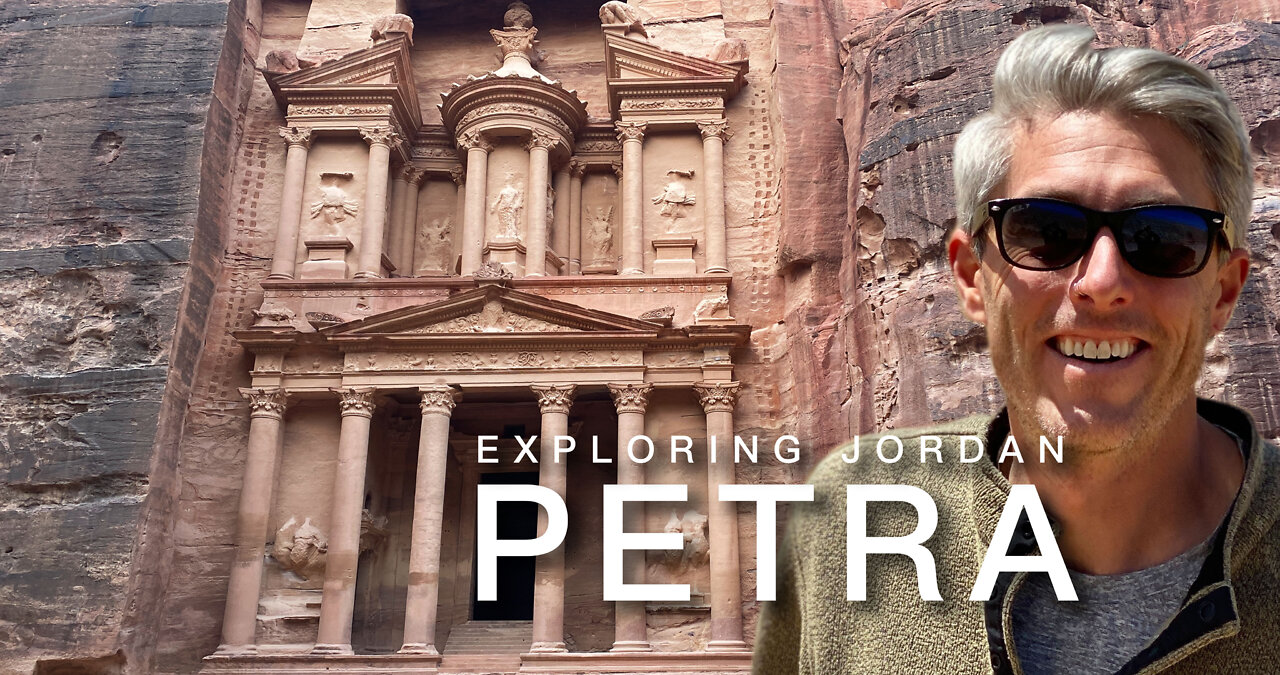Premium Only Content

Petra Jordan. Exploring the Ancient City.
Join Aaron as he explores the ancient city of Jordan and visits the site of the filming of Indiana Jones and The Last Crusade. The treasury of Petra and the Monastery are featured in this episode. Come hike in Jordan and discover the wonders of the Siq.
INSTAGRAM https://www.instagram.com/hisojourner/
ABOUT
"Petra (Arabic: ٱلْبَتْرَاء, romanized: Al-Batrāʾ; Ancient Greek: Πέτρα, "Rock", Nabataean: 𐢛𐢚𐢓𐢈), originally known to its inhabitants as Raqmu or Raqēmō,[3][4] is a historic and archaeological city in southern Jordan. It is adjacent to the mountain of Jabal Al-Madbah, in a basin surrounded by mountains forming the eastern flank of the Arabah valley running from the Dead Sea to the Gulf of Aqaba. The area around Petra has been inhabited from as early as 7000 BC, and the Nabataeans might have settled in what would become the capital city of their kingdom as early as the 4th century BC. Archaeological work has only discovered evidence of Nabataean presence dating back to the second century BC, by which time Petra had become their capital.[6] The Nabataeans were nomadic Arabs who invested in Petra's proximity to the incense trade routes by establishing it as a major regional trading hub.
The trading business gained the Nabataeans considerable revenue and Petra became the focus of their wealth. The Nabataeans were accustomed to living in the barren deserts, unlike their enemies, and were able to repel attacks by taking advantage of the area's mountainous terrain. They were particularly skillful in harvesting rainwater, agriculture and stone carving. Petra flourished in the 1st century AD, when its famous Al-Khazneh structure – believed to be the mausoleum of Nabataean king Aretas IV – was constructed, and its population peaked at an estimated 20,000 inhabitants."
FROM https://en.wikipedia.org/wiki/Petra
"The city of Petra, capital of the Nabataean Arabs, is one of the most famous archaeological sites in the world, it is Located 240 km south of the capital Amman and 120 km north of the red sea town of Aqaba (see the Map), Petra the world wonder, is undoubtedly Jordan's most valuable treasure and greatest tourist attraction, and it is visited by tourists from all over the world.
It is not known precisely when Petra was built, but the city began to prosper as the capital of the Nabataean Empire from the 1st century BC, which grew rich through trade in frankincense, myrrh, and spices.
Petra was later annexed to the Roman Empire and continued to thrive until a large earthquake in 363 AD destroyed much of the city in the 4th century AD.
The earthquake combined with changes in trade routes, eventually led to the downfall of the city which was ultimately abandoned.
By the middle of the 7th century Petra appears to have been largely deserted and it was then lost to all except local Bedouin from the area.
In 1812 a Swiss explorer named Johannes Burckhardt set out to ‘rediscover’ Petra; he dressed up as an Arab and convinced his Bedouin guide to take him to the lost city, After this, Petra became increasingly known in the West as a fascinating and beautiful ancient city, and it began attracting visitors and continues to do so today.
Petra is also known as the rose-red city, a name it gets from the wonderful colour of the rock from which many of the city’s structures were carved.
The Nabataeans buried their dead in intricate tombs that were cut out of the mountain sides and the city also had temples, a theater, and following the Roman annexation and later the Byzantine influence, a colonnaded street and churches.
In addition to the magnificent remains of the Nabataean city, human settlement and land use for over 10,000 years can be traced in Petra, where great natural, cultural, archaeological and geological features merge.
On December 6, 1985, Petra was designated a World Heritage Site,, also Petra was chosen by the Smithsonian Magazine as one of the 28 places you should visit them before you die."
FROM https://www.visitpetra.jo/Pages/viewpage.aspx?pageID=124
"Inhabited since prehistoric times, this Nabataean caravan-city, situated between the Red Sea and the Dead Sea, was an important crossroads between Arabia, Egypt and Syria-Phoenicia. Petra is half-built, half-carved into the rock, and is surrounded by mountains riddled with passages and gorges. It is one of the world's most famous archaeological sites, where ancient Eastern traditions blend with Hellenistic architecture.
Situated between the Red Sea and the Dead Sea and inhabited since prehistoric times, the rock-cut capital city of the Nabateans, became during Hellenistic and Roman times a major caravan centre for the incense of Arabia, the silks of China and the spices of India, a crossroads between Arabia, Egypt and Syria-Phoenicia. An ingenious water management system allowed extensive settlement of an essentially arid area during the Nabataean, Roman and Byzantine periods."
-
 LIVE
LIVE
Inverted World Live
1 hour agoHome is Where The Great Pacific Garbage Patch is | Ep. 148
3,777 watching -
 LIVE
LIVE
Drew Hernandez
20 hours agoTHE CURRENT STATE OF MAGA 2025 W/ GUEST: OWEN SHROYER
842 watching -
 34:21
34:21
Stephen Gardner
2 hours agoThey have NO IDEA what they just UNLEASHED!!
3.63K14 -
 LIVE
LIVE
Decoy
2 hours agoFinally
1,262 watching -
 LIVE
LIVE
TimcastIRL
2 hours agoTrump Calls Democrat RETARDED, Whistleblower EXPOSES Democrat FRAUD | Timcast IRL
6,539 watching -
 LIVE
LIVE
Akademiks
1 hour agoMeg Thee Stallion spent $2 mil on lawyers to win $59k vs Milagro! 50 Cent BURIES Diddy. SNAKES HIM!
1,038 watching -
 LIVE
LIVE
SpartakusLIVE
2 hours agoI'M BACK from Florida || The RETURN to the Spartan Stronghold
311 watching -
 LIVE
LIVE
Joker Effect
1 hour agoWhy is everything so DIFFICULT?! Cuffem, Gypsy Crusader, WVAGABOND is getting SUED?! IDuncle is mad!
451 watching -
 DVR
DVR
Flyover Conservatives
21 hours agoInside the Kill Zones: Kidnappings, Camps & the War on Nigerian Christians Exposed - Judd Saul | FOC Show
3.18K1 -
 1:02:35
1:02:35
MattMorseTV
3 hours ago $13.92 earned🔴We just got the CONFIRMATION.🔴
14.6K40